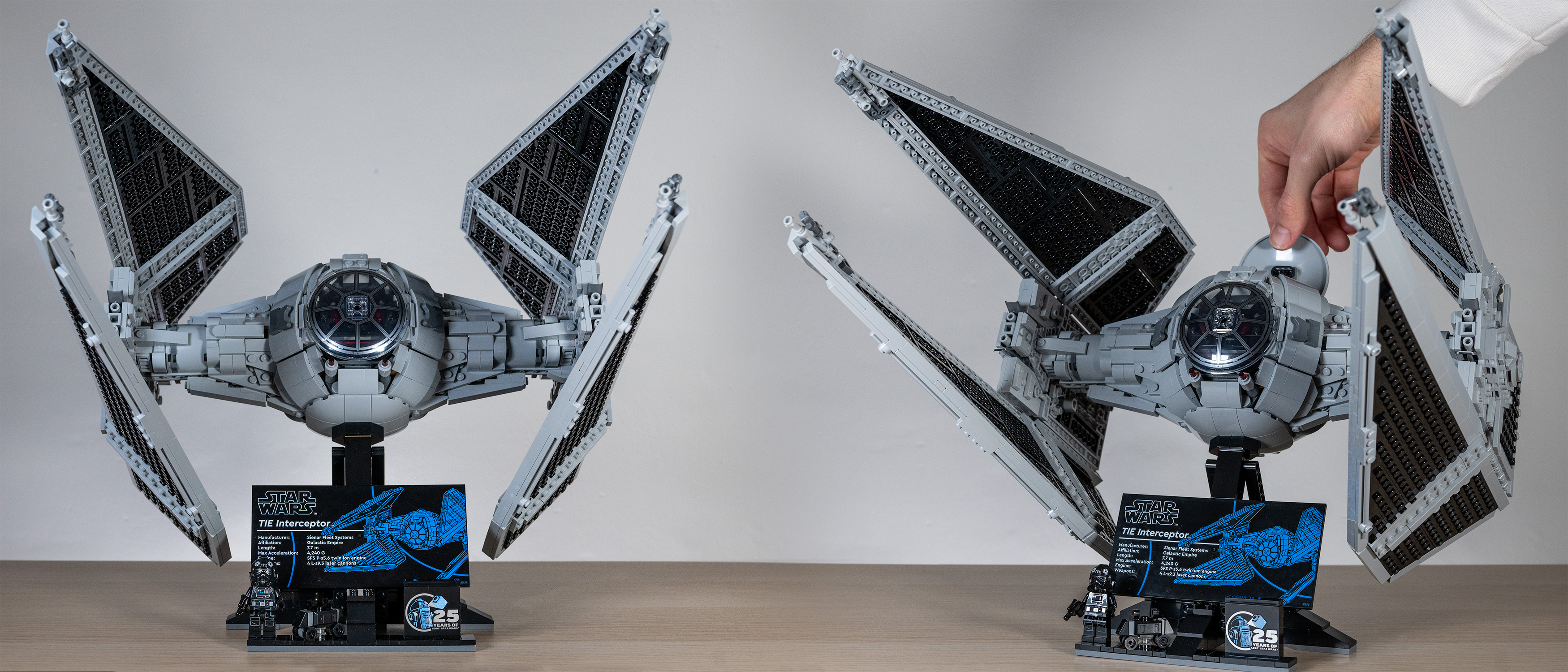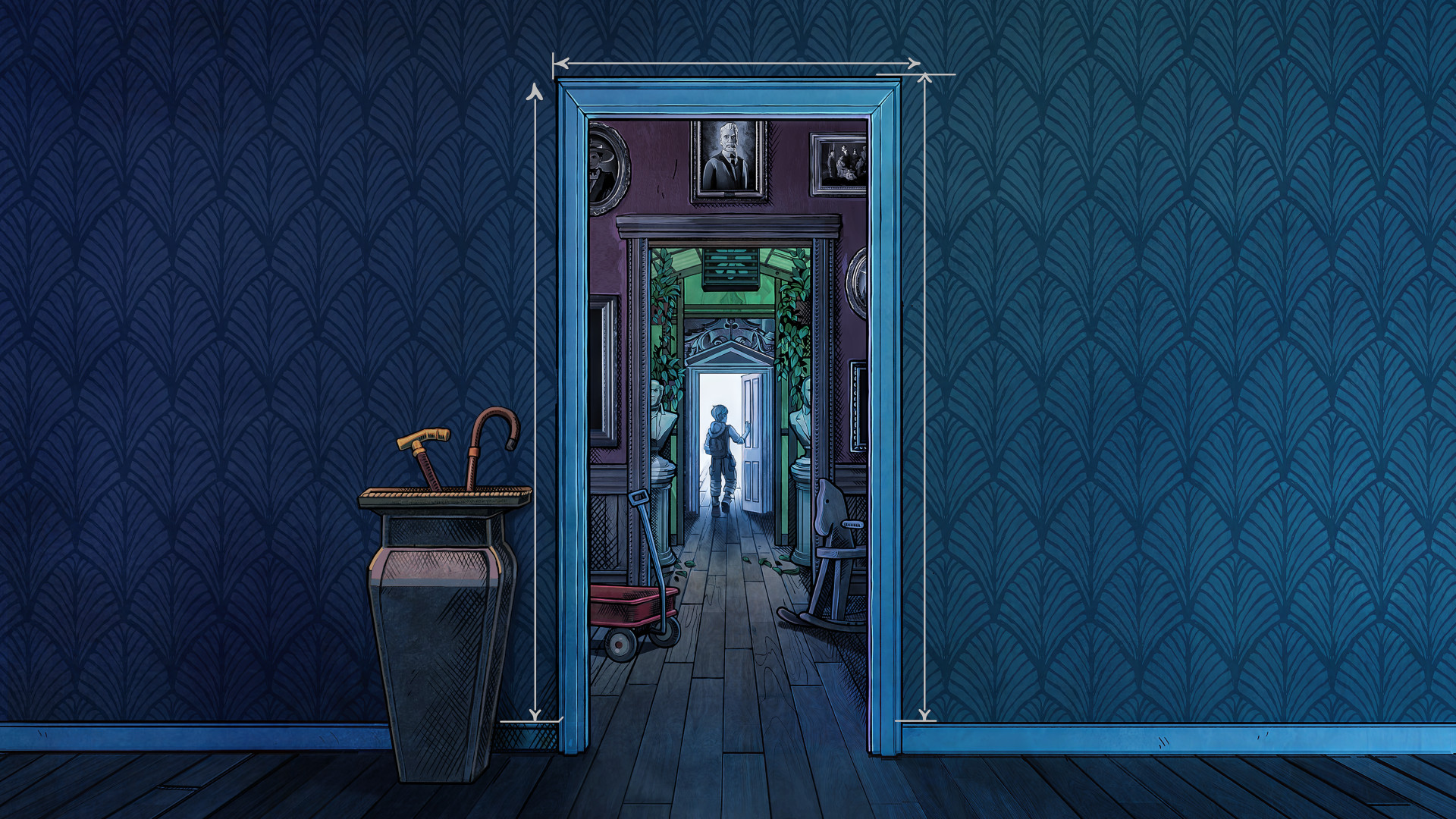GamesRadar+ Verdict
The last time Lego released a UCS TIE Interceptor, Attack of the Clones and Revenge of the Sith weren’t part of the Star Wars lexicon. Released nearly a quarter of a century later, the Lego Star Wars TIE Interceptor (75382) improves on the original’s aesthetic in almost every way. It boasts arguably the finest mid-size ship interior Lego has ever created and the greebling is simply exquisite. Bits ping off here and there and I prefer the matt plaque to the new glossy one, but overall this is an elegant take on a UCS classic, for a more civilized time.
Pros
- +
A dead ringer for the movie TIE Interceptors
- +
Sturdier than the UCS X-Wing Starfighter
- +
Beautifully printed minifigure
- +
My favorite UCS starfighter cockpit
- +
Immense improvement over the original
Cons
- -
Tricky sticker placement
- -
Small details prone to falling off
- -
Glossy plaque doesn't look as good as the older matt variant
Why you can trust GamesRadar+
The Lego UCS TIE Interceptor (75382) depicts one of the most iconic spaceships in the Star Wars universe, which is most impressive given that it didn’t appear until Return of the Jedi. If you need evidence of just how revered this evolution of the TIE Fighter really is, Lego honored it back in the year 2000 with the TIE Interceptor (7181) and X-Wing Fighter (7191) as the very first Ultimate Collector Series releases. Two of the best Lego sets of their day, if you ask me.
So, when the Billund-based brick builders decided to update the latter in 2023, with the Lego X-Wing Starfighter (75355), I would have bet my last galactic credit the TIE Interceptor would’ve been next. And with 2024 marking Lego's 25th anniversary, it was the perfect time to revisit this classic UCS set.
The Lego UCS TIE Interceptor retails for $229.99/£199.99 and occupies the smaller UCS vehicle slot in Lego’s annual Star Wars release schedule. Past incarnations include the Lego Luke Skywalker's Landspeeder (75341). This is not to be confused with the larger UCS slot, which boasts some of the biggest and best Lego Star Wars sets ever made. The most recent additions are the Lego Jabba’s Sail Barge (75397) and the Lego UCS Venator (75367).
I spent hours in the early noughties pouring over my Lego catalogs, and the original UCS TIE Interceptor and X-Wing Fighter were near the top of my wishlist. So, I couldn't wait to start piecing this set together. But is it worthy of the Empire’s finest or a bucket of studs? Let’s find out…
Lego Star Wars TIE Interceptor features
| Price | $229.99/199.99 |
| Ages | 18+ |
| Pieces | 1,931 |
| Minifigures | 1 |
| Height | 13” (32cm) |
| Width | 16” (40cm) |
| Depth | 13” (33cm) |
| Item Number | 75382 |
Lego Star Wars TIE Interceptor Build
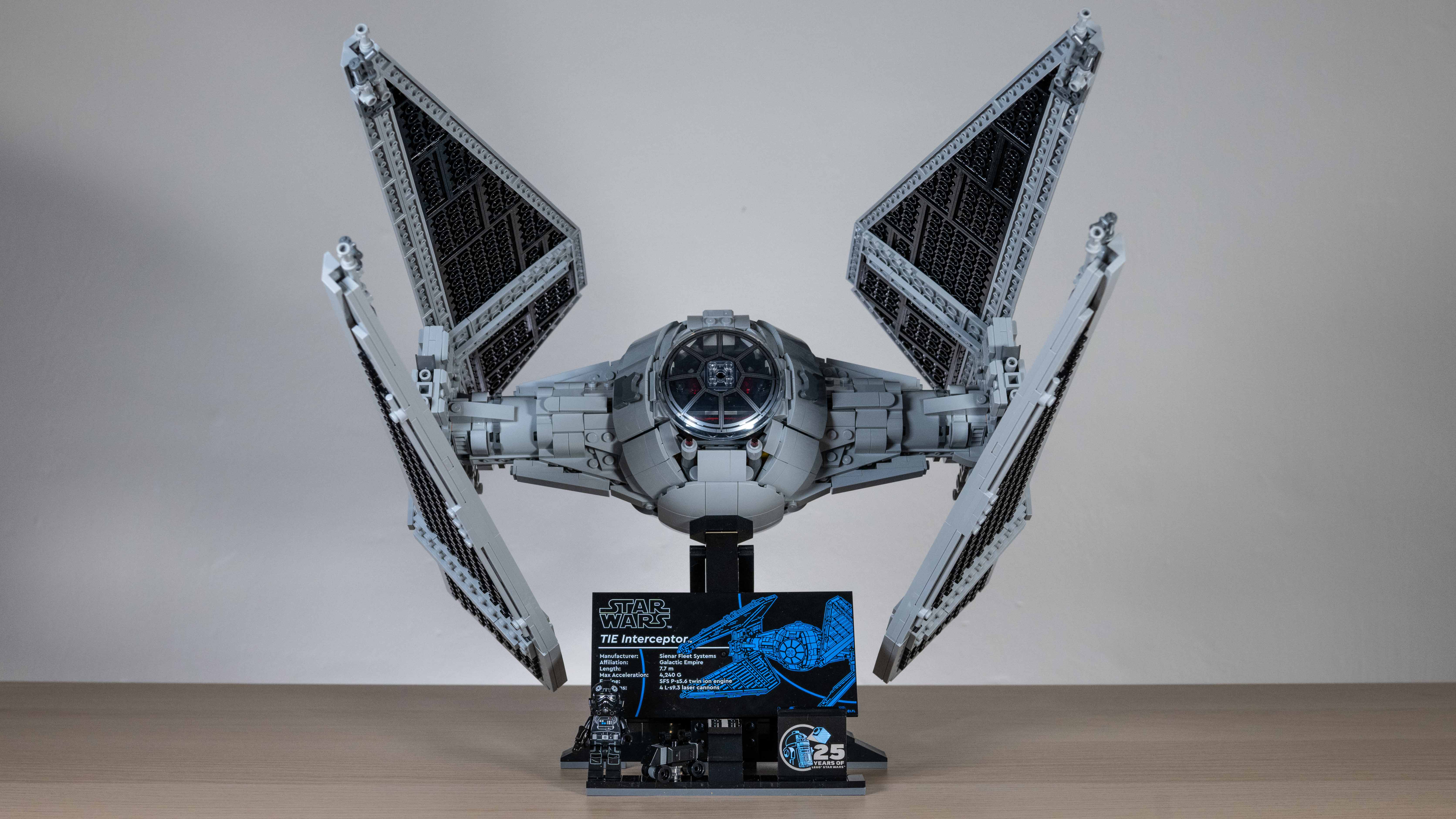
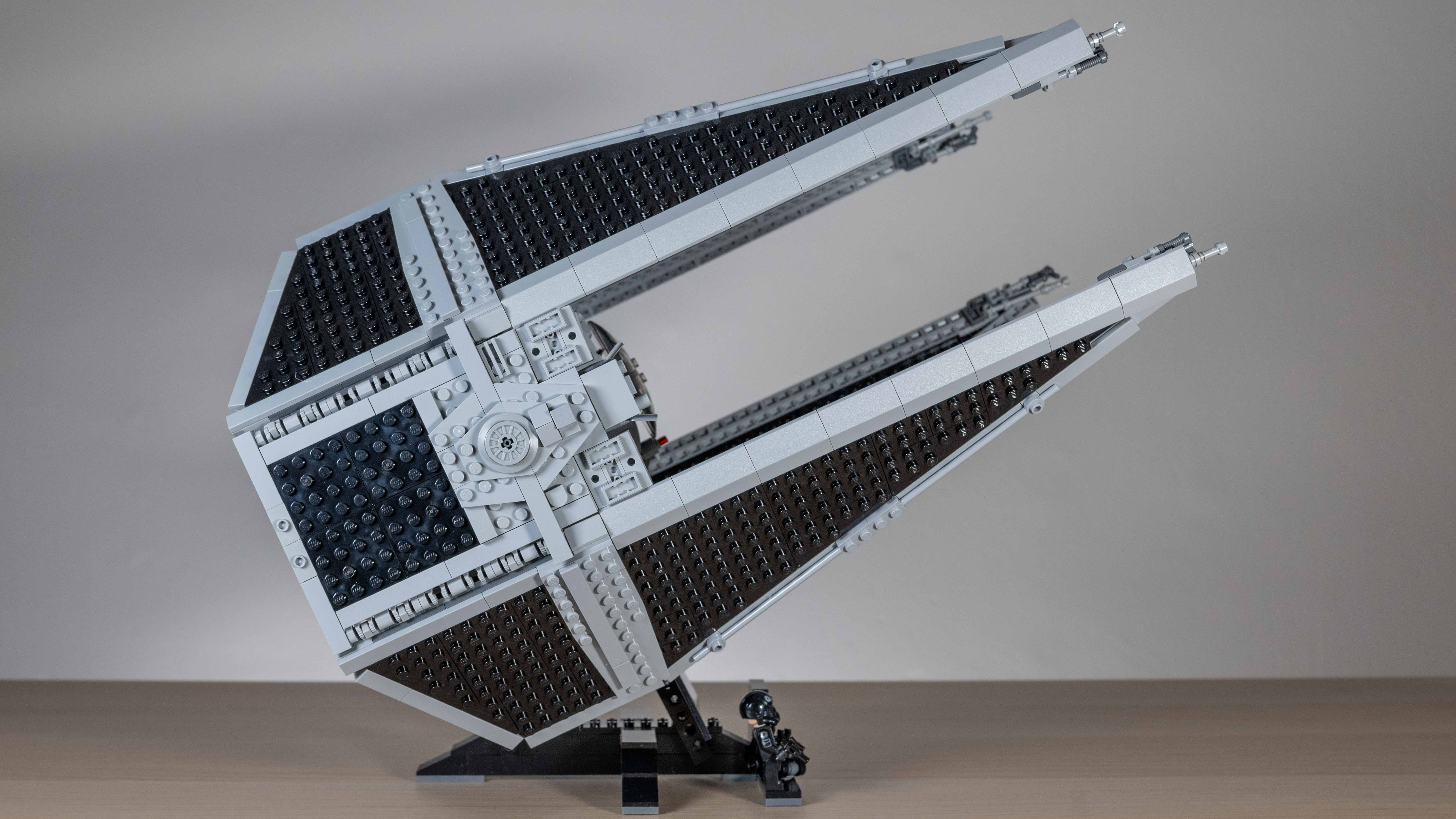
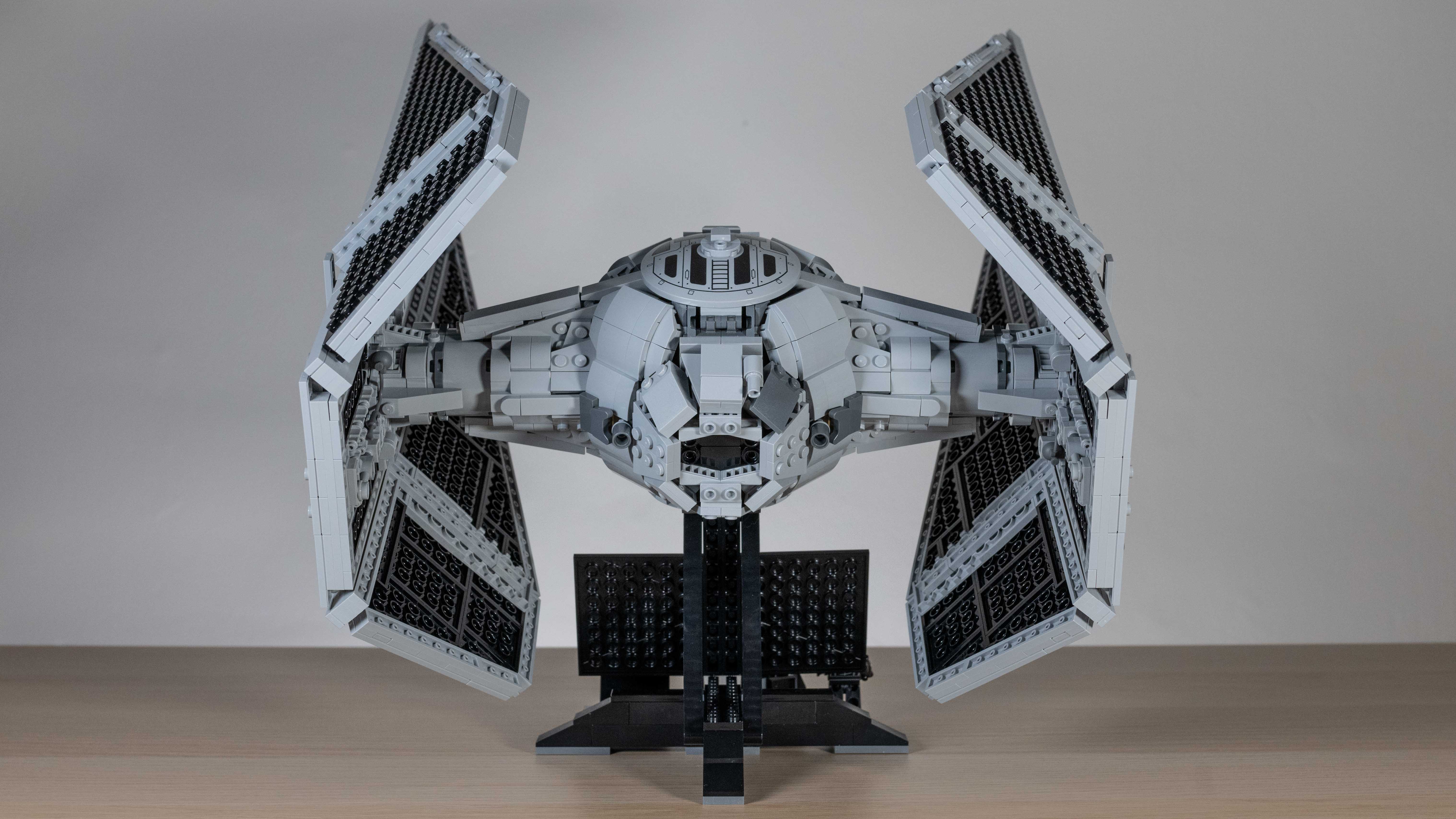
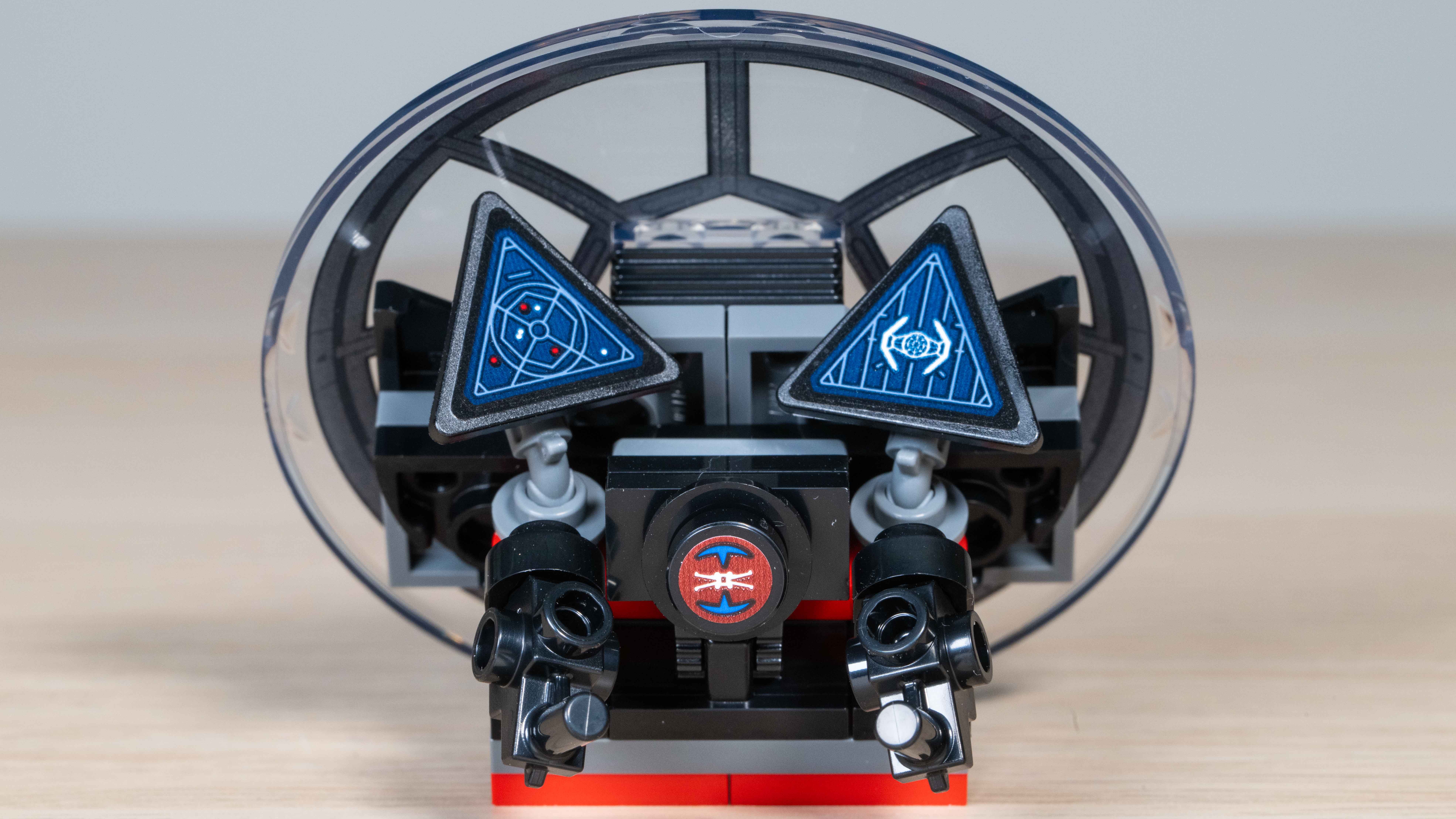
- 1,931 pieces
- Tricky triangular sticker placement
- Very few Technic pieces for a build of this size
The TIE Interceptor comprises 1,931 pieces – 22 less than the X-Wing Starfighter – and took me around five-and-a-half hours to build. I was thrown right into the deep end at the beginning of the build by immediately making a start on the cockpit interior. This ultimately houses all of the set's 15 stickers, and bar the circular targeting computer, they’re all triangular. This makes them not only difficult to apply but extra attention must be paid to ensure you apply each sticker the right way around.
The fact some of the triangular pieces attach via clips makes it very easy to misjudge which way up the piece will ultimately sit within the cockpit. I’d also recommend using a pair of tweezers when applying them as they're all reasonably small and fiddly.
It’s worth making sure that everything within the cockpit snaps together tightly because as you progress with the build, anything that falls off within the cockpit will be mighty difficult to clip back into place, as you can barely squeeze a finger or two into the cramped space.
Repetition is part and parcel when it comes to UCS sets, but the size and number of wing sections make them take up half of the build
With much of the cockpit interior completed, you move onto the internal structure of the wing attachments, which includes a few Technic pieces. There are fewer Technic pieces here than your average UCS build, which I like. You then move onto the exterior plating of the wing-attachment arms and cockpit, which includes plenty of slopes, producing a largely studless aesthetic.
Once the cockpit is finished, it's time to build the stand. This then allows you to mount the cockpit on the stand while you build the wings. The first stage in building the wings is constructing the two rectangular mid-sections. They are virtually identical, but some excellent greebling keeps them interesting. You then move onto the four irregular quadrilaterals, which make up the rest of the wings.
The wing sections are repetition-heavy, with each wing comprising three layers of plates and a cleverly implemented gray border. Repetition is part and parcel when it comes to UCS sets, but the size and number of wing sections make them take up half of the build. This is an 18+ set for good reason. And probably a set most builders will want to split over a few days to make its repetitive nature more enjoyable.
Lego Star Wars TIE Interceptor: Design
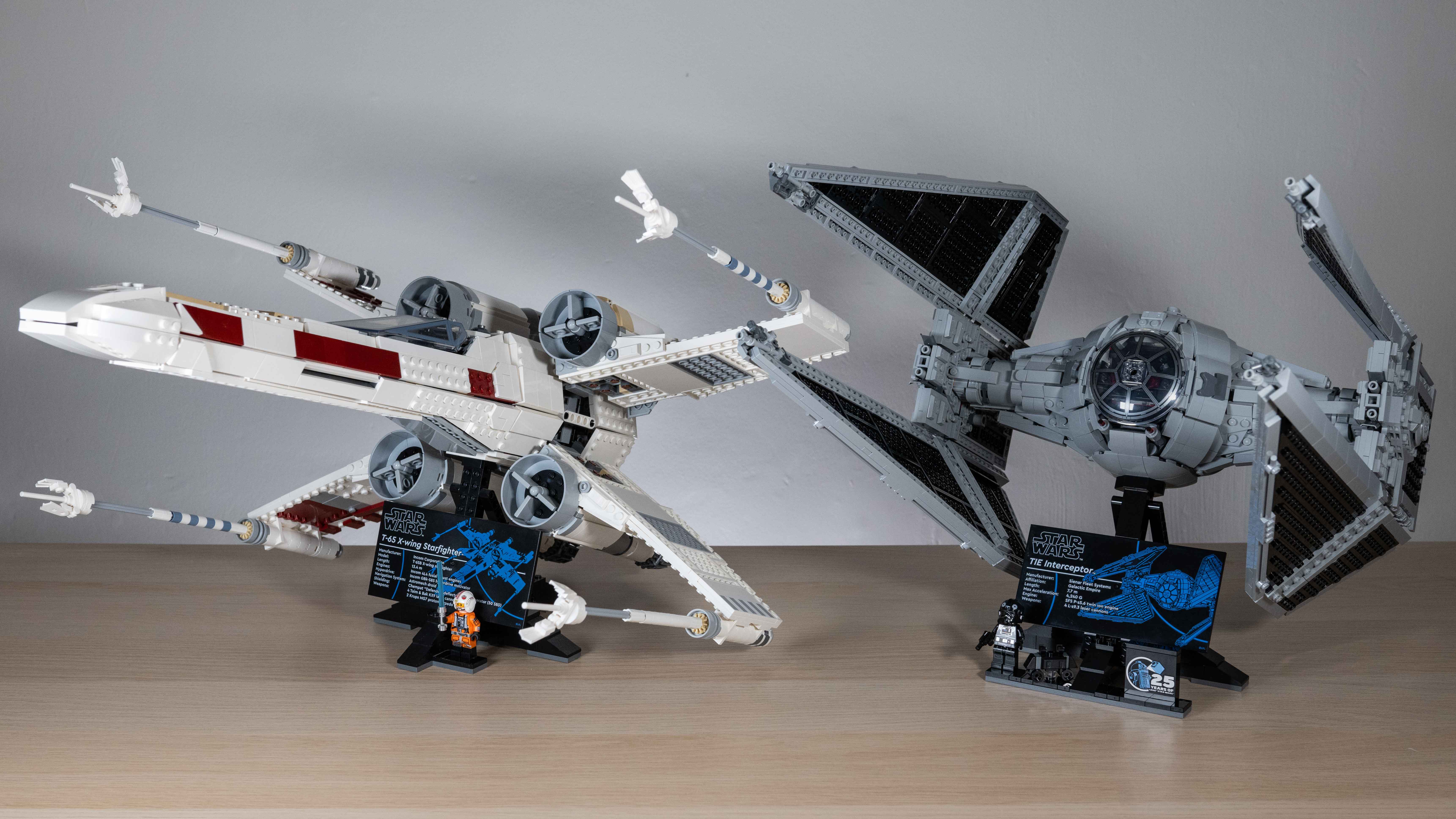
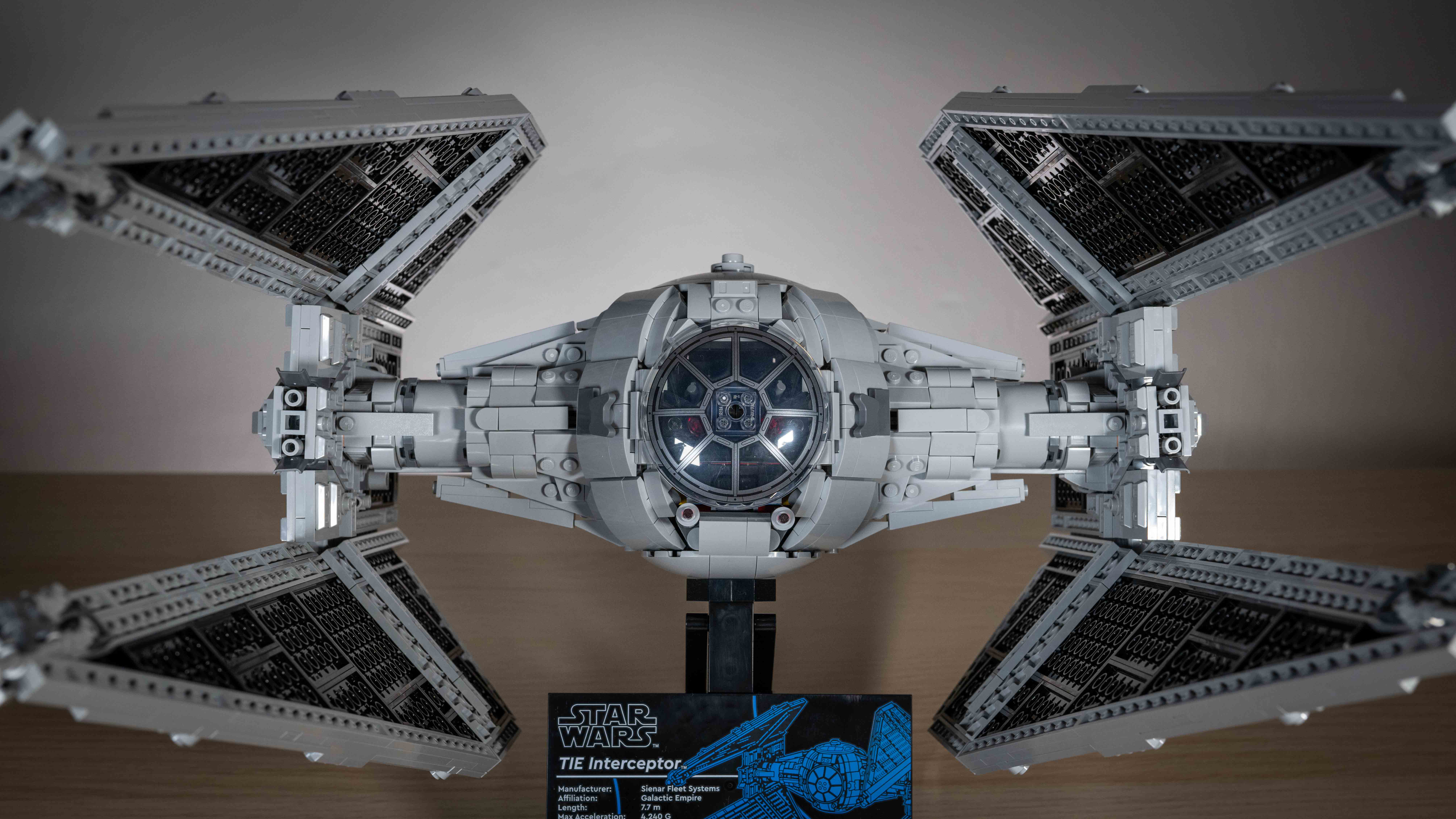
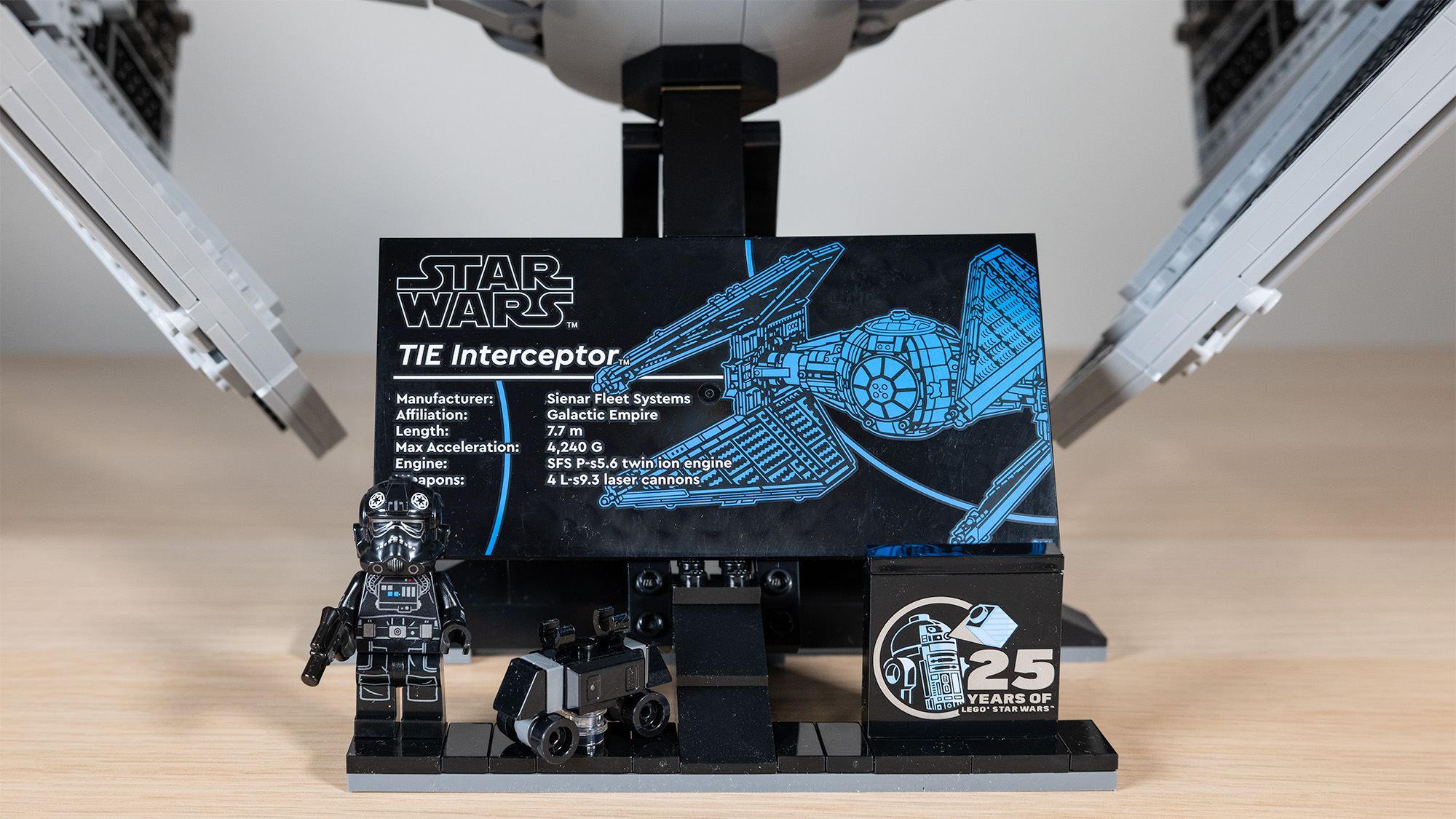
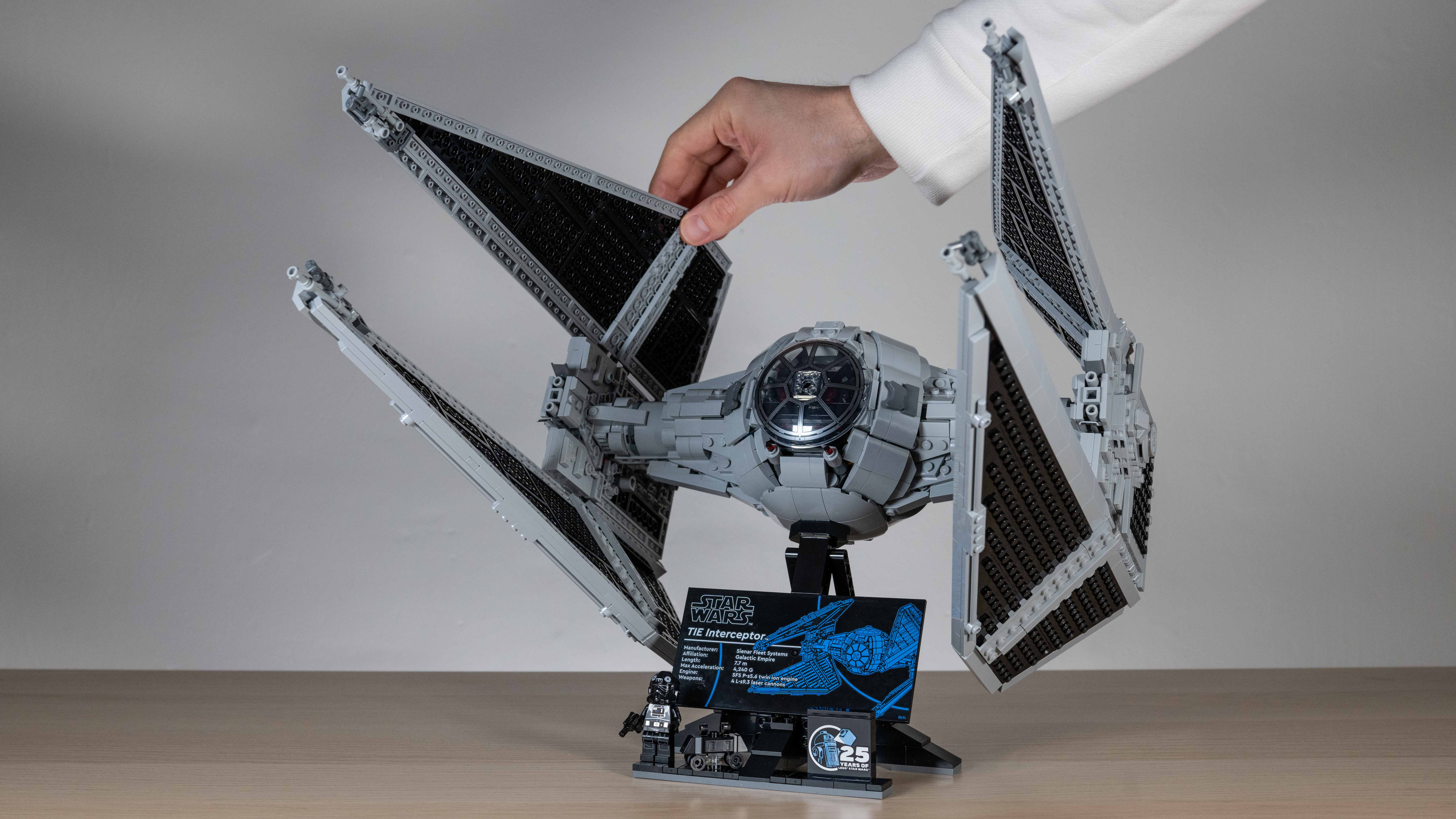
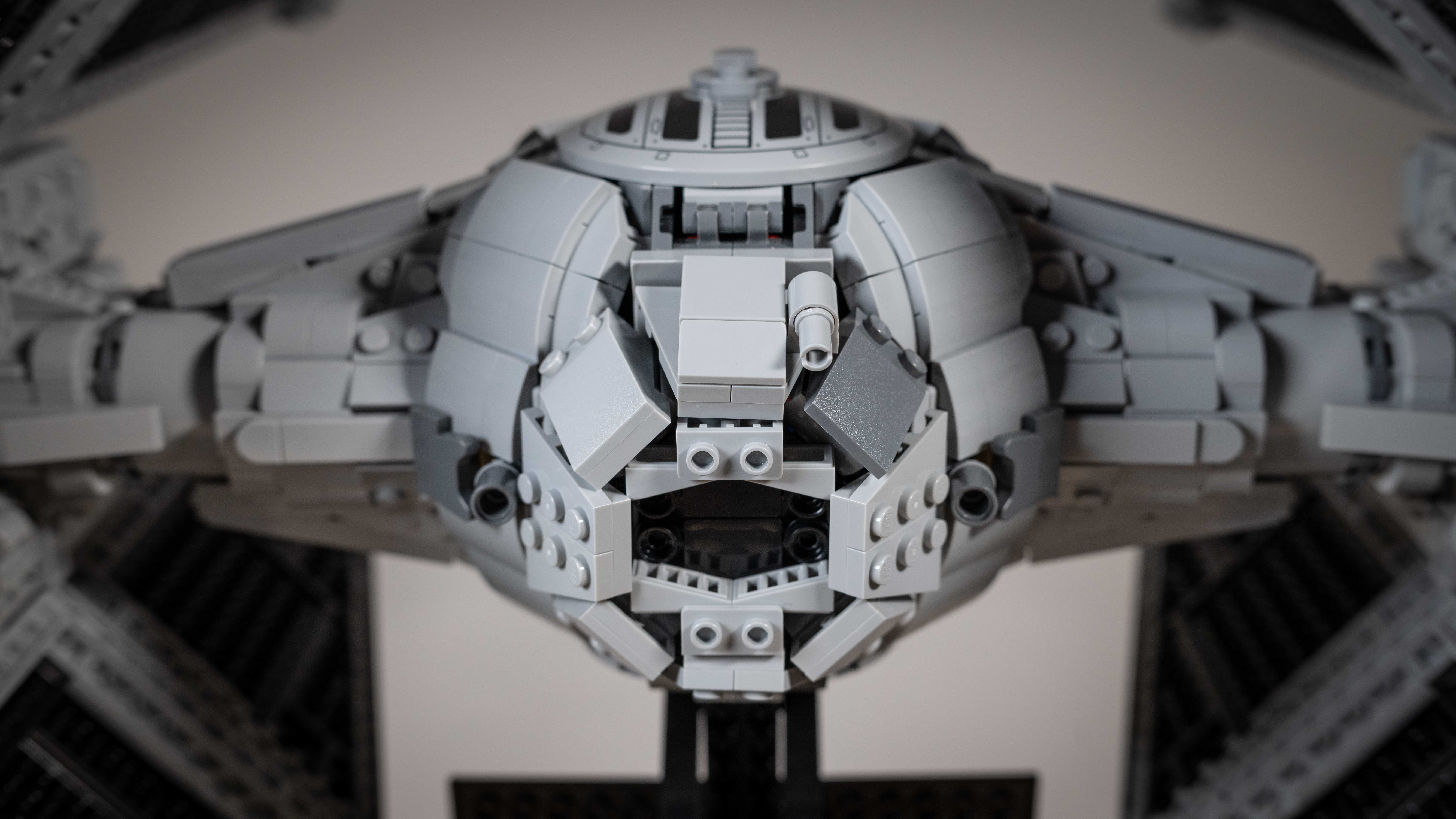
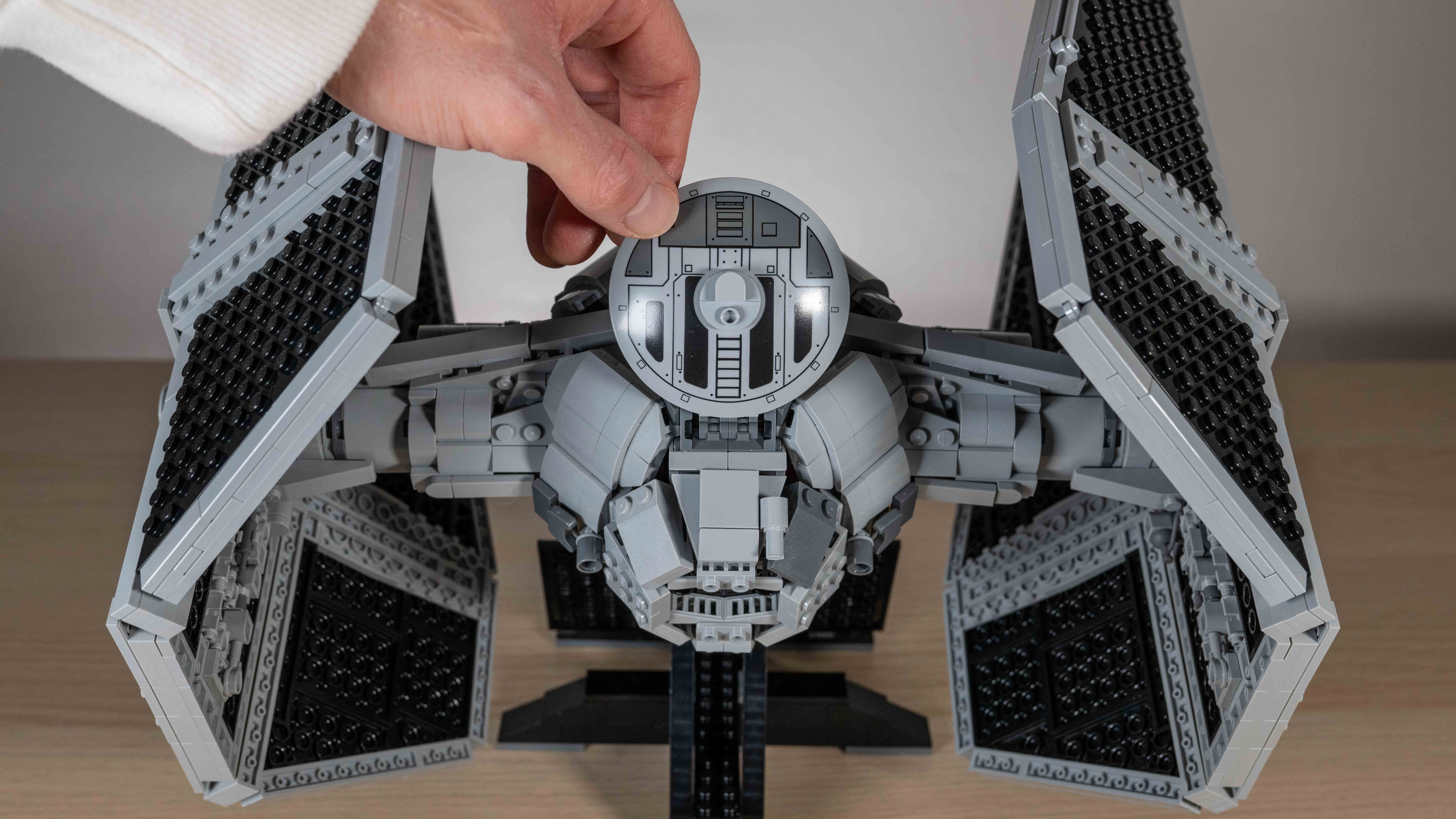
- Beautiful spherical cockpit with detailed interior
- Not minifigure scale, but the cockpit accommodates the minifigure well
- Absolutely nails the TIE Interceptor aesthetic
As a child, I must have spent hours looking at the original UCS TIE Interceptor (7181) from the year 2000 alongside the UCS X-Wing (7191) in the Lego catalog. The X-Wing is the better of these two retro models. Even back then, the TIE Interceptor looked boxy and spindly in comparison. But now, I think the tables have turned. Having built both the new X-Wing and TIE Interceptor, I have to say, the TIE is the better model.
Both sets look exquisite when compared to the source material, but the X-Wing suffers from a structural flaw that causes some serious wing droopage. And it’s gotten worse over time. Suffice to say, “lock S-foils in attack position” is easier said than done, since the mechanism seems to have come loose or simply worn, despite the model only sitting on display. Plus, the weight of the model on the pair of 2x2 curved slopes that sit at the very top of the X-Wing’s stand ping off within moments of being reattached to the point that I now leave them off entirely.
Time will tell if the weight of this hulking TIE Interceptor will produce similar problems. But I could tell while I was building it that it’s a much more structurally sound model. Sure, it’s a much more stable and compact design compared to the X-Wing’s exceedingly long wings and nose, but the model is more stable where it counts. That said, pieces do fall off. Plenty of tiny details are attached to a single stud or clip and they’re prone to vacating their station when the model is moved. Probably the most frustrating culprit is that instantly recognizable windshield. I try to avoid resting my thumb on it when moving the model because it almost always falls off.
Overall, this is a very faithful recreation of the source material – it blows its 24-year-old sibling out of the sky with a pair of laser cannons
But, this is a UCS Lego set. It’s not built for practicality and it’s not built for play. So long as it’s stable enough to hold itself together while being displayed and not touched, I’m happy. The X-Wing fails in that regard, but as far as I can tell, the TIE Interceptor should succeed.
As is often the case with a good Lego set, pictures cannot do this thing justice. Stacking it up against prototype imagery reveals a strikingly good resemblance. The cockpit is slightly more bulbous than it should be and the attachments that sit between the cockpit and wing are slightly thicker, but making these thinner would have probably impacted the model’s stability. Overall, this is a very faithful recreation of the source material – it blows its 25-year-old sibling out of the sky with a pair of laser cannons.
The greebling throughout is very tastefully done. Look at the model from the front and you’ll notice two Lego shovels, in between each wing, used to replicate the ship’s targeting sensors. On either side of the cockpit are a pair of cleverly positioned gray Lego video game controllers. And the laser cannons on the tip of each wing are represented using gray Mini Space Guns and gray lightsaber hilts. All fantastic little details.
The inner wings are covered in anti studs (the uglier rear of Lego plates). But I really can’t see a way around this, without the tooling of many new pieces (which would be far too expensive) or by increasing the thickness of each wing, which wouldn’t look right. Ultimately, the inside of each wing is plain and streamlined, with minimal structural inclusions and even some clever greebling. It doesn’t really damage the overall aesthetic.
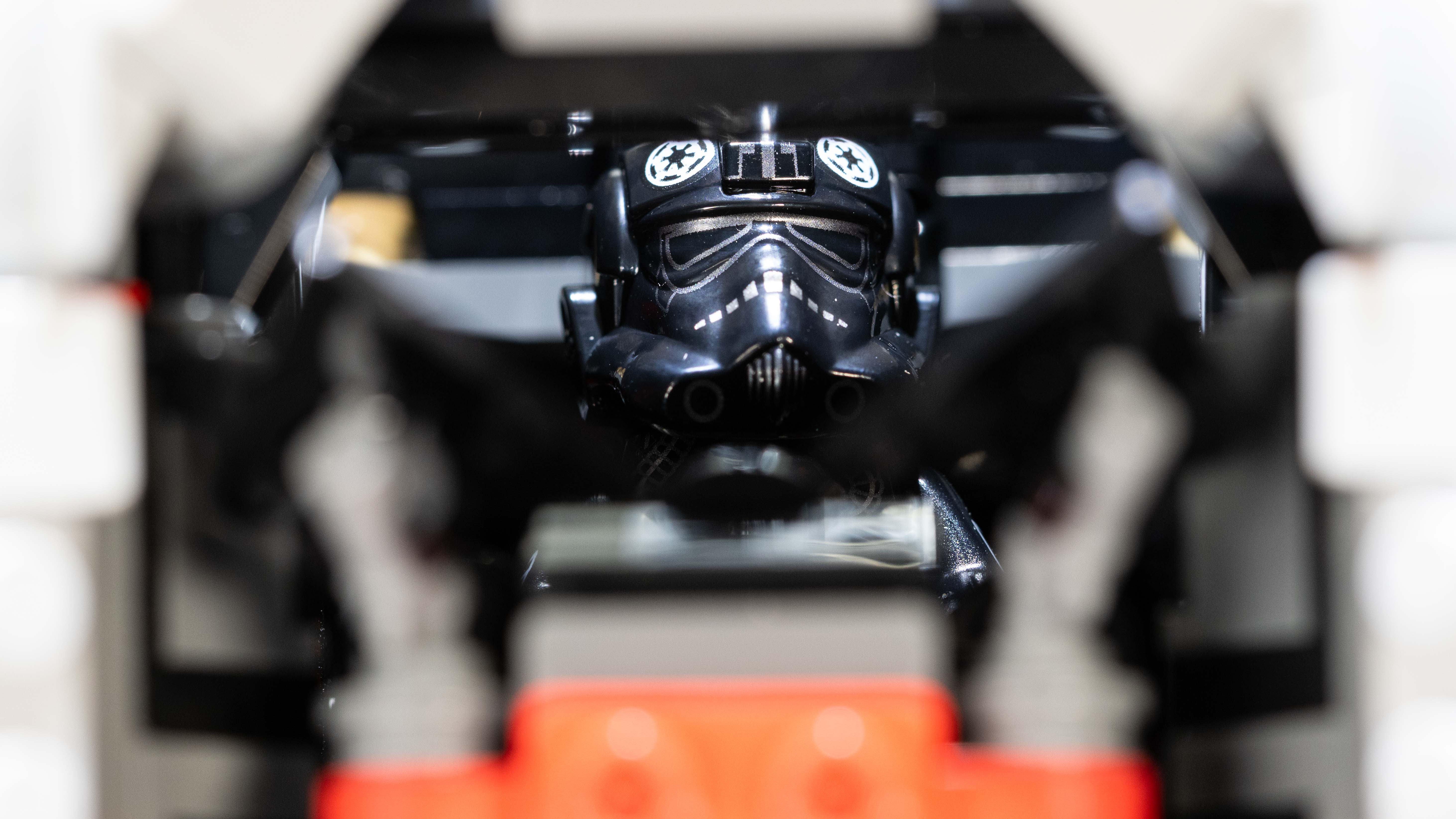
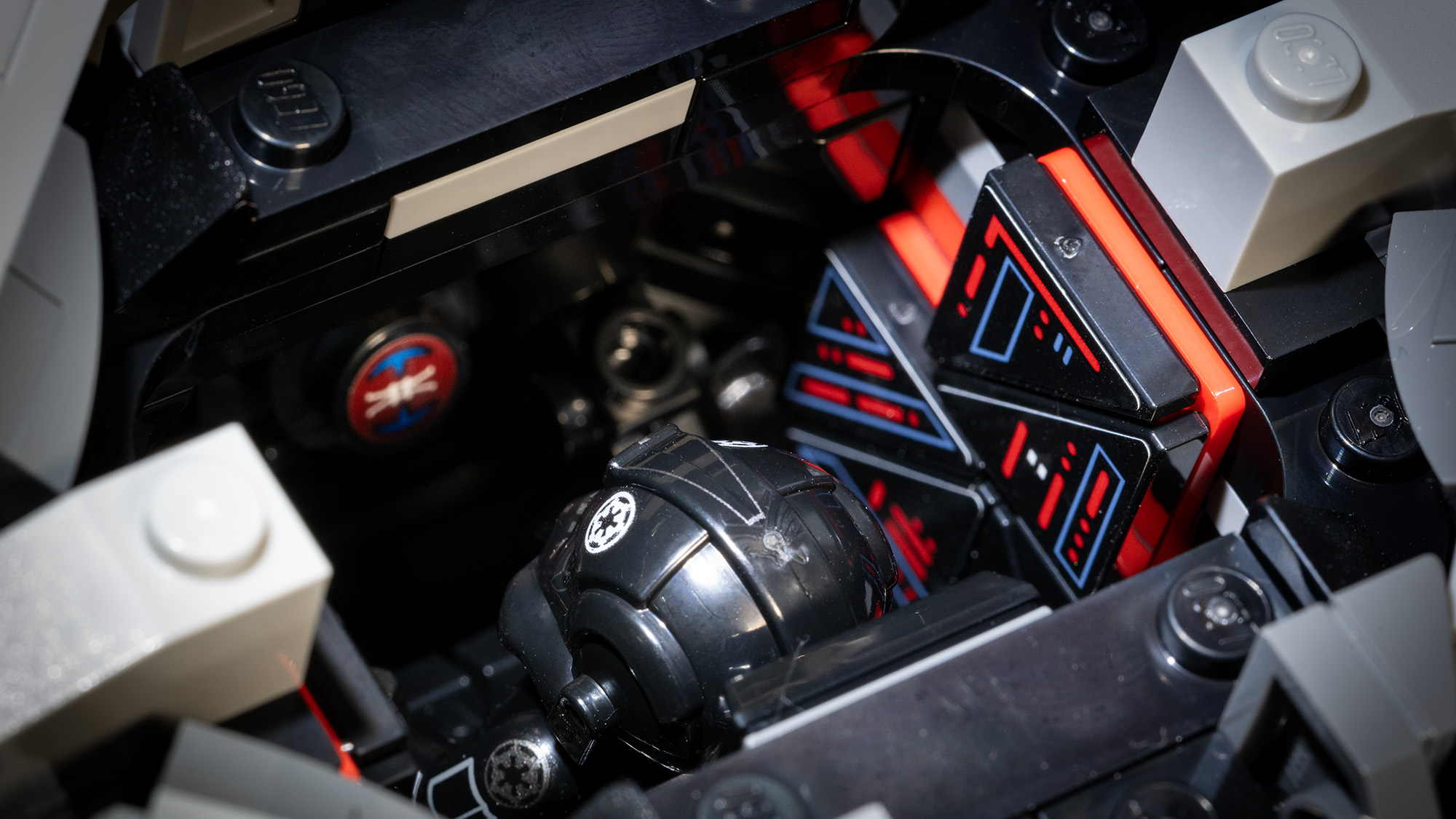
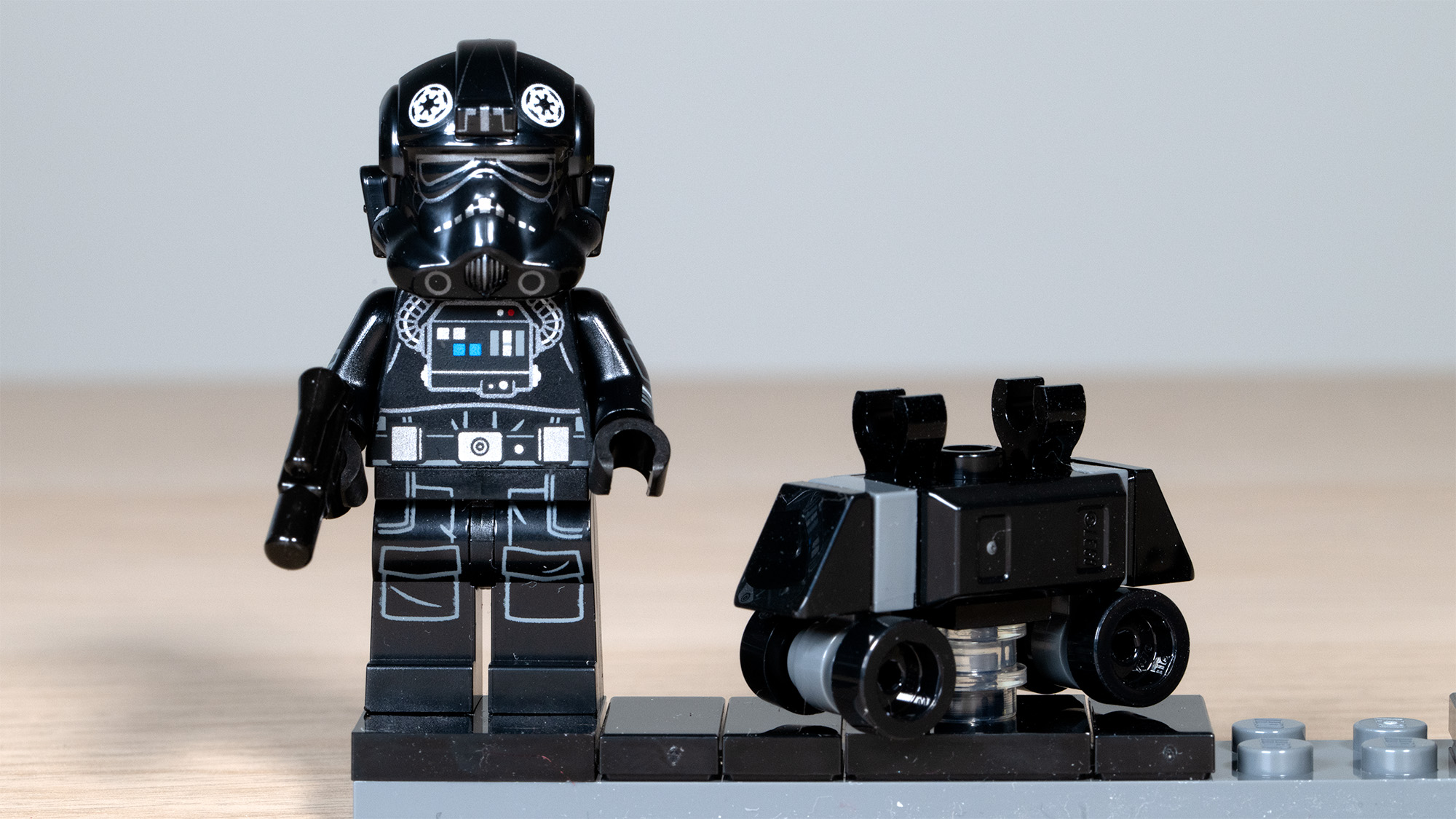
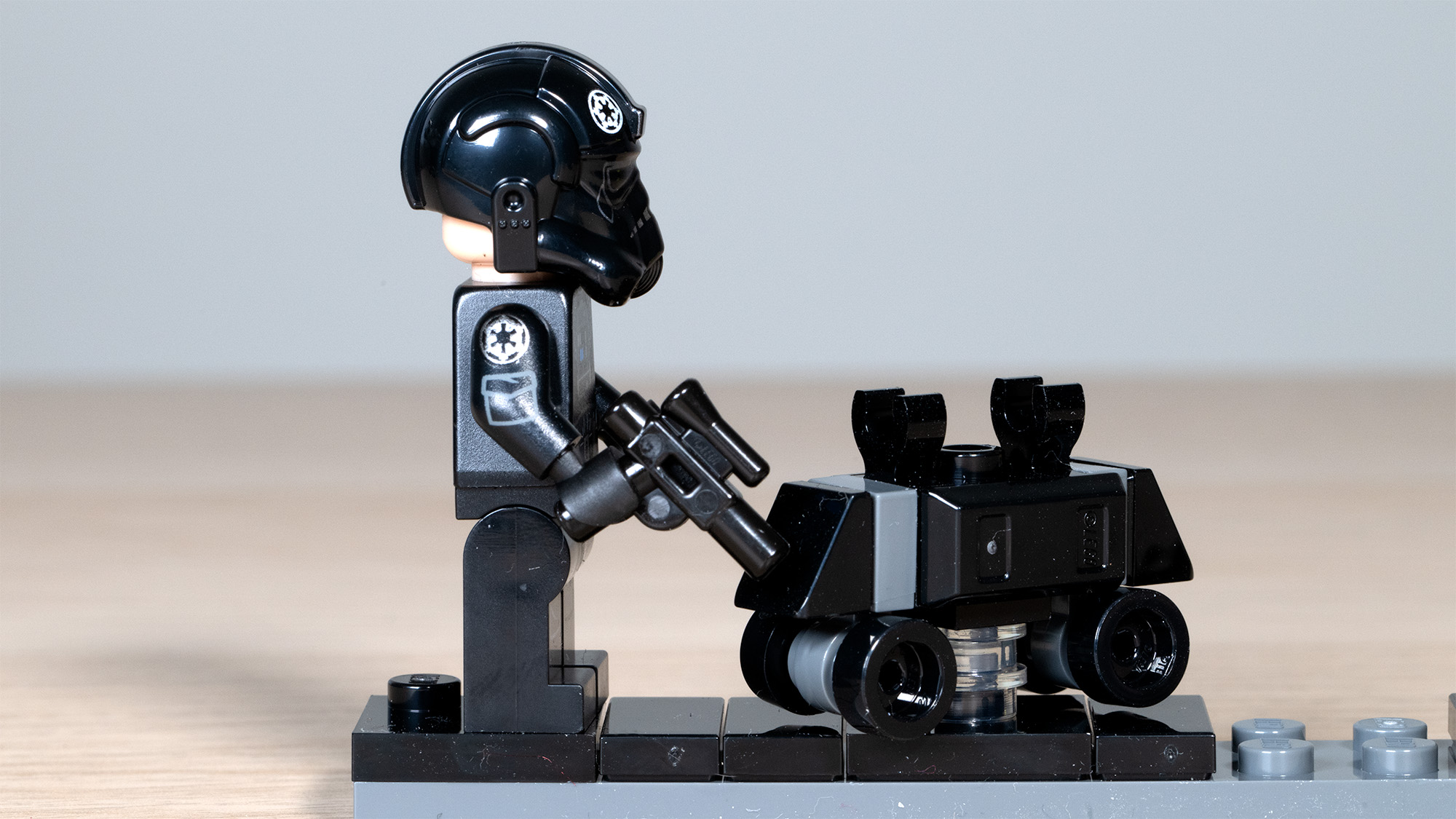
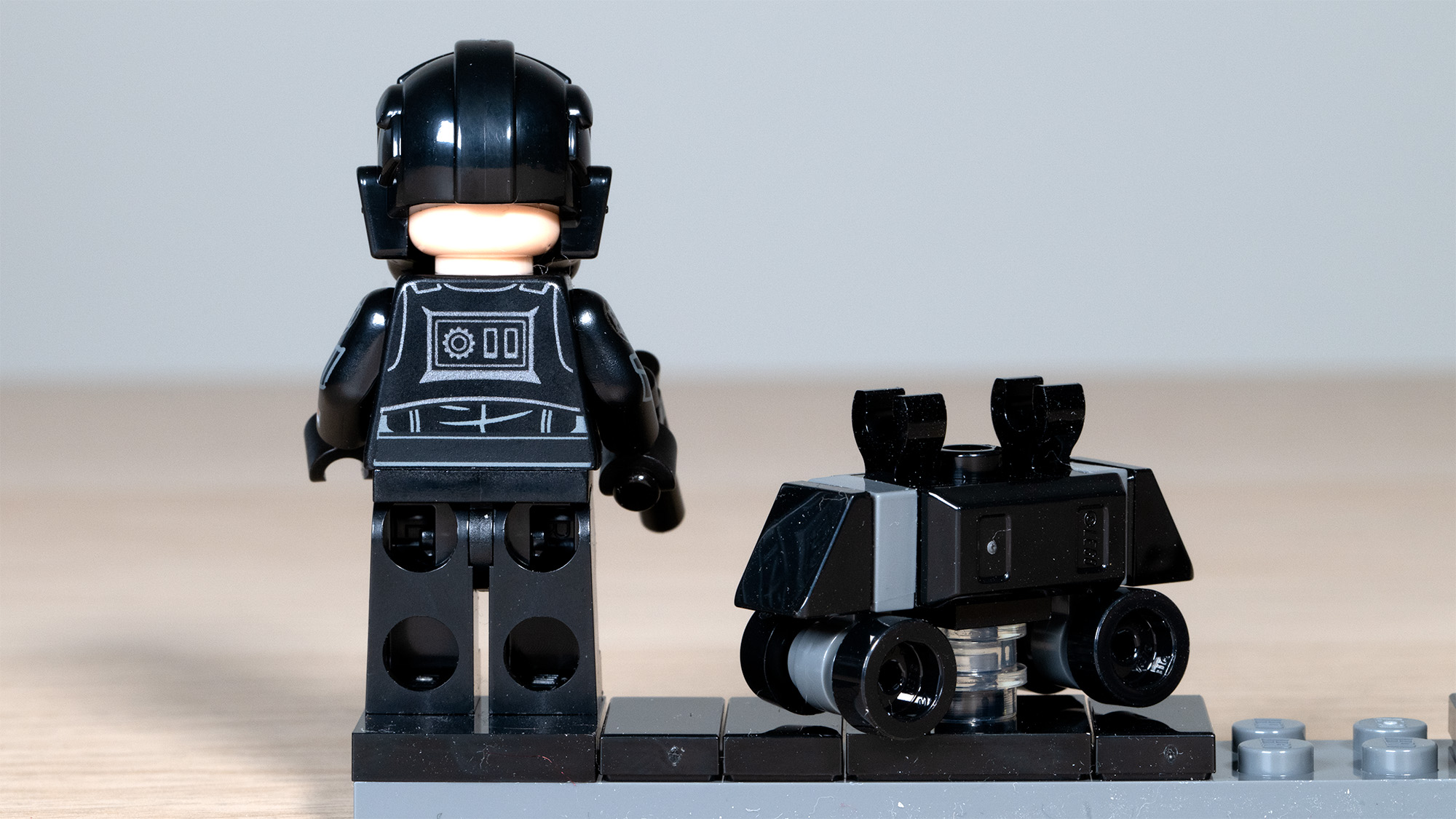
Arguably my favorite part of the ship is the rear, which is where the twin ion engine is located (TIE being an acronym). In fact, there’s so much greebling goodness, it’s almost a shame the designers opted for the – admittedly great-looking – printed hatch on the top of the cockpit, instead of depicting it with pieces. But this certainly comes down to a matter of taste and is in no way a negative.
Talk of printed bricks brings me onto the UCS series’ famous printed plaque. The X-Wing Fighter’s plaque has a matt finish and I much prefer it to the TIE Interceptor’s glossy variant. Fresh from the box, I could see little scratches on it and it’s a fingerprint magnet, too. And since these ships go together like Han and Leia, it’s a shame the plaques aren’t uniform. Still, it’s a world away from the days when you had to apply a huge sticker, which was a nerve-wracking experience indeed.
It’s a shame the interior of the TIE Interceptor’s cockpit is so hidden because it’s a thing of beauty. Lego keeps pushing the boundaries when it comes to interiors and this might be my favorite small-to-medium-sized UCS vehicle interior yet. And while this ship is not minifigure scale, the TIE Pilot slots into the cockpit beautifully.
The little pilot is as fine a minifigure as you’d expect, with a finely printed male head, helmet, arms, torso (front and back), hip and legs. This is the gold standard in TIE pilots. It’s similar to the female minifigure included in the TIE Fighter & X-Wing Mash-up (75393) and the minifigure included in the TIE Bomber (75347) sets, but with printed arms, which is a bonus.
Although not technically a minifigure, you also get a mouse droid. This is a lovely little mini-build and sits next to the pilot on the stand nicely.
Should you buy the Lego Star Wars TIE Interceptor?
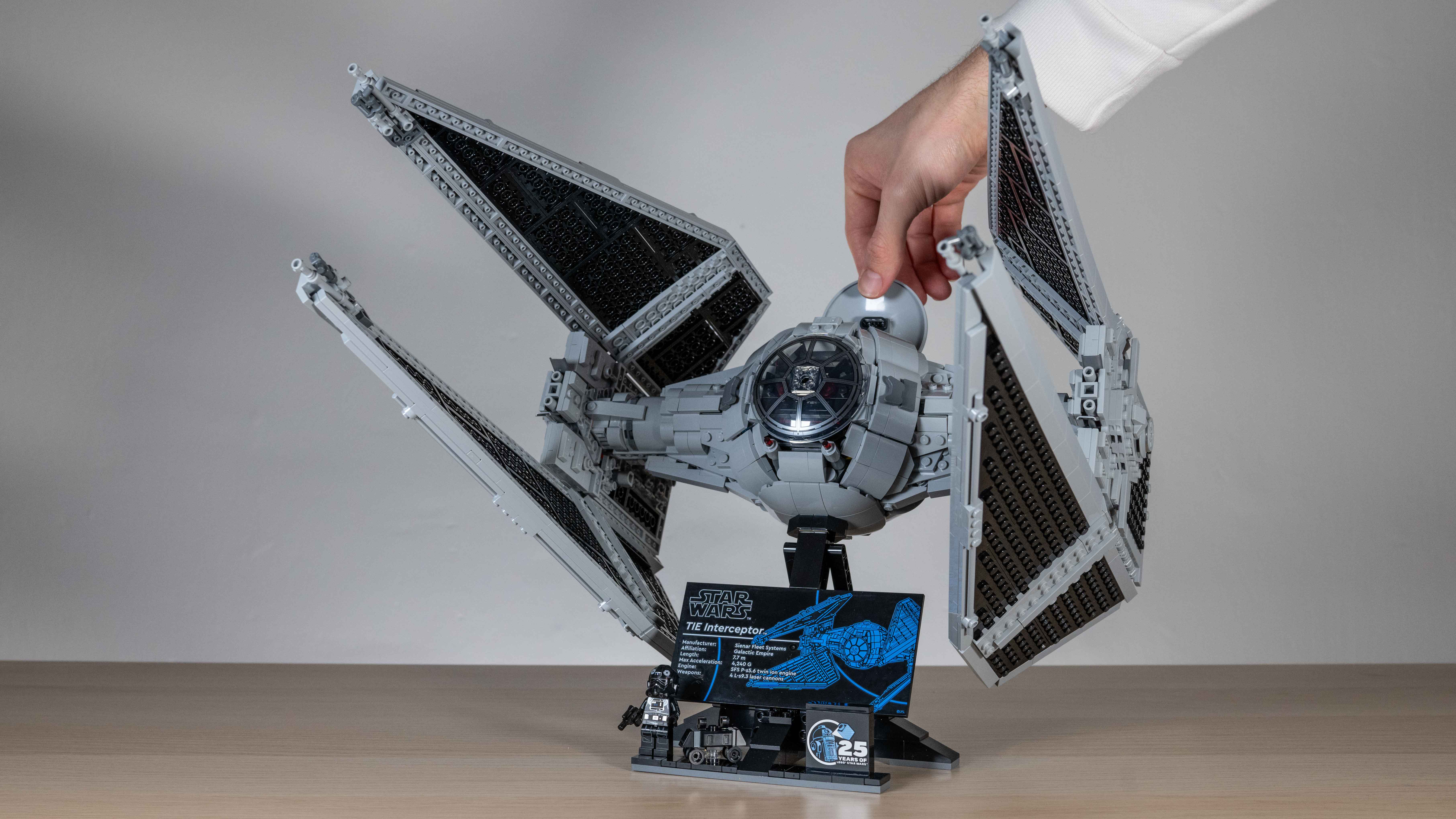
As Lego Star Wars celebrates its 25th anniversary, few models illustrate just how far the theme has come quite like the UCS TIE Interceptor (75382). It makes the Noughties original look like something from Atari’s 1983 Star Wars arcade game in comparison, and even by today’s lofty standards, the TIE Interceptor is a very good-looking UCS set indeed.
I knocked off half a star because bits are prone to falling off in transit and sometimes they’re not easy to reinstall, as well as the move to a glossy plaque, which simply doesn’t work as well as the matt variant (nor match its counterpart, the X-Wing Starfighter). Otherwise, this is a fantastic ode to how far Lego Star Wars has come in a quarter of a century. The cockpit interior is unmatched by any other starfighter set, the greebling is exquisite, and even the TIE Pilot is a perfect representation of a modern minifigure. I’m wondering how Lego could improve upon this set, should it get revisited for Lego Star Wars' 50th.
Buy it if...
✅ You have the UCS X-Wing Starfighter (75355)
The TIE Interceptor is the perfect accompaniment to the X-Wing Starfighter. These two UCS sets have been joined at the hip ever since they debuted the Ultimate Collector Series back in 2000.
✅ You’ve limited space for display
This isn’t a small set by any means, but it’s a much more practical UCS set for a flat or dorm room than, say, the ridiculously large UCS Venator, or even a Master Builder Series playset like Mos Eisley Cantina (75290).
Don't buy it if...
❌ You're Rebel scum
Not a fan of the Galactic Empire? Then you’re looking in Alderaan places! Luckily, there are plenty of Republic, Rebel, and Resistance-themed Lego sets out there, like the excellent Lego Millennium Falcon (75375).
❌ You want a set with more playability
Lego Star Wars UCS sets generally opt for realism over playability. If you’re looking for a Lego set you can play with, one of my favorite playsets over the past few years is the incredible Ghost & Phantom II (75357).
How we tested the Lego Star Wars TIE Interceptor
Disclaimer
This review sample was provided by Lego.
I built the Lego Star Wars TIE Interceptor (75382) over roughly five-and-a-half hours and in three sittings. It sat in my living room on display for a couple of weeks and I also tested its durability by moving it around, especially when photographing it. I’ve also built and reviewed the closely related Lego Star Wars X-Wing Starfighter (75355) and many other Lego Star Wars sets, too. I’ve been collecting Lego since the early 90s, making me extremely well-versed in the world’s favorite construction toy.
For more information on our procedure, take a look at how we test products.
For more brick-based goodness, don't miss our guides to the best Lego Super Mario sets. You can also get some money off with these Lego deals.

When he's not putting together Lego or board game reviews for us, Mike is Deputy Editor of N-Photo: The Nikon Magazine. He also brings over 10 years of experience writing both freelance and for some of the biggest specialist publications.
